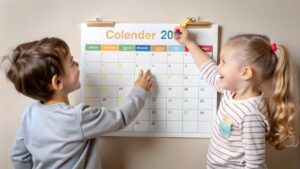The Education Blog

How to Home School Kids at Different Grade Levels
Homeschooling one child is no small task — so when you’re teaching two, three, or more children at different stages of learning, it can quickly feel like you’ve taken on a full-time job (without the lunch break).
One child is practising phonics, another is writing a persuasive essay, and your eldest needs help tackling algebra. Sound familiar? You’re not alone. Teaching children of mixed ages and abilities is one of the most common — and most challenging — realities of the homeschool journey.
But here’s the good news multi-grade homeschooling doesn’t have to be chaotic. With the right systems, mindset, and a little creativity, it’s entirely possible to meet everyone’s needs — and even enjoy the process along the way.
This post will walk you through practical, experience-based strategies to help you build a homeschool family plan that works for all ages. From shared learning ideas to one-on-one teaching techniques, you’ll learn how to keep things running smoothly — even when everyone’s learning something different.
Why Multi-Grade Homeschooling Is Worth It
Before we dive into the how-to, let’s take a moment to acknowledge the why. Because yes, teaching different age groups is challenging — but it’s also incredibly rewarding.
Benefits of Homeschooling Multiple Grade Levels:
- Stronger sibling relationships through collaboration and mentoring
- Customised pacing for each child’s needs
- More flexible learning environment compared to traditional schooling
- Shared resources and overlapping content across subjects
It’s not about teaching multiple school years in isolation. It’s about creating a connected learning environment where everyone benefits from the variety.
The Key: Structure with Flexibility
Create a Predictable Framework
Multi-grade homeschooling thrives on routine — but not rigid scheduling. The goal is to establish consistent rhythms while allowing room for shifting needs.
Consider creating a daily anchor schedule, such as:
- Morning circle: Everyone together for calendar time, announcements, or group reading
- Focused blocks: Assign individual tasks or rotate 1:1 time
- Group project time: Engage in science experiments, art, or history together
- Quiet independent work: Older kids study while younger ones rest or do hands-on play
A flexible structure gives each child clear expectations — and gives you breathing room.
Combining Subjects Across Ages
One of the smartest ways to simplify multi-grade teaching is to teach subjects together, especially content-based ones like science, history, art, and geography.
How This Works:
- Use the same topic for all but tailor expectations. For instance, while studying the solar system, your 6-year-old might draw planets while your 11-year-old writes a research paragraph.
- Encourage group discussions and collaborative experiments where possible.
- Choose unit studies or curriculum designed for family learning — they’re a lifesaver when teaching across ages.
This not only streamlines your planning but builds a shared knowledge base that sparks rich conversations around the dinner table.
To enhance group learning, consider these group teaching strategies that work at home, especially when managing varied attention spans.
Independent Learning: Your Secret Weapon
You can’t clone yourself, but you can empower your children to learn more independently, especially as they grow.
How to Encourage It:
- Set up visual schedules or checklists so each child knows what’s next
- Use self-paced online programmes or workbooks for subjects like maths or spelling
- Establish a routine where older kids start independently, allowing you to focus on younger learners early in the day
And if you’re wondering whether this level of freedom leads to progress, it certainly can — when paired with consistent check-ins and personalised support.
Rotation Time: Divide and Conquer
Rotating your attention is essential when you have more than one child needing one-on-one instruction.
Rotation Strategy Example:
- While one child reads aloud with you, another works on handwriting, and the third listens to an audiobook
- After 20–30 minutes, rotate the tasks so each child gets focused time with you
This approach creates intentional one-on-one moments while keeping everyone engaged — no more endless interruptions or feeling like you’re being pulled in three directions at once.
Embrace Asynchronous Learning
Not all learning has to happen at the same time — and it definitely doesn’t have to be taught by you in real time.
Try:

- Pre-recording lessons or instructions for older kids to watch later
- Using educational videos as part of your teaching toolkit
- Letting older children work ahead or revisit previous lessons at their own pace
By embracing this model, your homeschool becomes more efficient and more aligned with real-world learning rhythms.
Hands-On for the Littles, Depth for the Big Kids
One challenge with multi-age teaching is giving younger children enough attention while keeping older ones challenged.
How to Balance It:
- Keep little hands busy with sensory bins, puzzles, or themed play boxes during teaching time
- Encourage older kids to go deeper with research projects, reading extensions, or teaching a concept back to their siblings
- Build in creative tasks that stretch older learners, from presentations to planning group activities
It’s not about giving the same amount of time to every child every day — it’s about meeting needs dynamically.
Use Your Environment Wisely
When space allows, designate learning zones:
- A quiet space for focused work
- A creative corner for messy play or projects
- A reading nook with audio options and comfortable seating
Even if you have a small home, defining zones — even with baskets or shelves — can mentally prepare children for different types of learning.
And if you’re also managing group work, tie this into your homeschool family plan to create a natural flow for shared tasks and solo time.
Delegate (Yes, Really)
You don’t have to teach every subject, every child, every day. Use resources that take some of the load off your shoulders.

- Online classes or subscription platforms for advanced subjects
- Co-ops or community tutors
- Educational apps that align with your curriculum
Think of these not as replacements, but as tools — your job is to guide the learning, not do it all.
Progress Over Perfection
Some days will go beautifully. Others may end with someone crying under the table (and it might be you). That’s okay.
Multi-grade homeschooling is a dynamic, evolving process. Progress, not perfection, is the goal.
Keep a record of wins, however small:
- A moment of sibling collaboration
- A concept finally understood after weeks of effort
- A day where everyone finished their work without a meltdown
These are the milestones that matter.
You’ve Got This!
Homeschooling children of different ages isn’t about juggling perfectly — it’s about learning how to balance. It’s about leaning into rhythms, not rigid schedules. About combining, rotating, and adjusting based on real life.
With patience, observation, and the willingness to tweak your approach, you’ll find your stride. Your home won’t look like a traditional classroom — and that’s the point. You’re offering something better an education built on connection, flexibility, and trust.
So take a deep breath. Choose one strategy from this list to try this week. And remember — you’re not falling behind. You’re moving forward, together.









